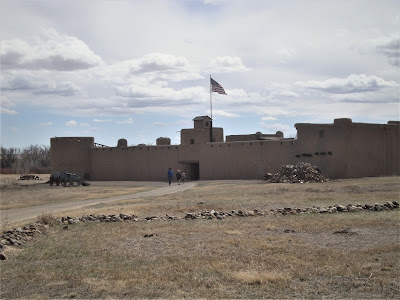Of course, there was also a lot of nothing along US-50 in Kansas, but at least nothing fell off the car
The Santa Fe Trail auto route does not follow US-50 in eastern Kansas -- it's a little farther north, along US-56 -- but out by Dodge City the highway and the original trail actually follow the same route, more or less, for quite a few miles. There are numerous historic markers, although no major sites until you get into Colorado and Bent's Old Fort a few miles east of the city of La Junta. Bent's Old Fort is a National Historic Site associated with the Santa Fe Trail.
The fort is an interesting example of a time period in the National Park Service that's unlikely to ever be repeated: the era of reconstruction and replication. NPS went on a rebuilding binge in the 1960's and 70's; a combination of lack of funds and a change in philosophy since then means the preferred approach now is to stabilize whatever ruins remain and put up markers showing where stuff used to be. Fort Bowie in Arizona is a good example of the latter approach. Bent's Old Fort is a total reconstruction dating from the tail end of the rebuilding boom.
The National Park Service got lucky with its reconstruction of Bent's Old Fort. Reconstructing former military installations, like Fort Learned in Kansas or Fort Union Trading Post in North Dakota, was fairly easy. The U.S. Army was a firm believer in standardization. If you've been to one 19th century military post, you have basically been to them all. The enlisted mens' barracks, the officers' quarters, the post hospital, the overall layout of the post, you name it. Standard plans across the country. The only thing that might vary is the building material (in the Southwest, for example, the Army used adobe bricks instead of wood frame construction). Bent's Old Fort, however, was privately owned. There was no standard plan involved. So how do the Park Service manage to get it so right?
 |
| Press used to flatten bison hides into compact bundles for shipment east. |
The current fort was built on the site of the original, but by the time the National Park Service got the site, what was left was archeological, not structural. Constructed by brothers William and Charles Bent and their business partner Ceran St. Vrain in 1833 and abandoned less than twenty years later, the adobe ruins had quickly crumbled and vanished. The three men established a trading post on the Arkansas River near the point where the Santa Fe Trail crossed from U.S. territory into Mexico in 1829. After deciding upon a site the men sent for workers experienced in using adobe for construction to build the fort.
Bent's thrived for about twenty years. The three business partners established good relations with local Native American tribes; William Bent himself married a Cheyenne woman. The trading post became a popular stop for travelers along the Santa Fe Trail as well as serving as a rendevouz point for both fur trappers and Indians.
The partners had established the post to capitalize on the popularity of beaver fur. Within a few years, however, the supply of beaver had dwindled along and, luckily for the beaver, so had the demand for its fur (had it stayed popular, the beaver could easily have been trapped to extinction). The focus shifted to buffalo hides.
Interestingly, the interpretive film at Bent's mentions that by the 1840's the Cheyenne were reporting that the buffalo herds were getting smaller and buffalo were becoming harder to hunt. In most histories I've read, the extirpation of the American bison in the United States is described as happening after the Civil War, but the history at Bent's suggests the process became visible a couple decades before, at least on the western edge of the Great Plains. I was reminded of a talk I heard over 20 years ago at an environmental history meeting -- a historian there suggested that Native American hunters would have driven the bison into extinction regardless of whether or not white hunters or government policy were involved. It caused quite a stink at the time -- no one wants to admit that the Native Americans could be wasteful or short sighted, but they were* -- but it appears that the Cheyenne had noticed diminishing herds even if they may not have realized the role they were playing in creating the problem. .
War with Mexico disrupted trade at Bent's. The fort became a staging area for the U.S. military as well as the site of a government Indian agency. Trade with the Indians fell off, and in 1849 Bent's Old Fort burned down. There was some suspicion that William Bent torched it on purpose. Whether or not he did, when he rebuilt it was at a different site near the Arkansas River. That site, Bent's New Fort, today exists only as ruins.






I would like to visit it...
ReplyDelete